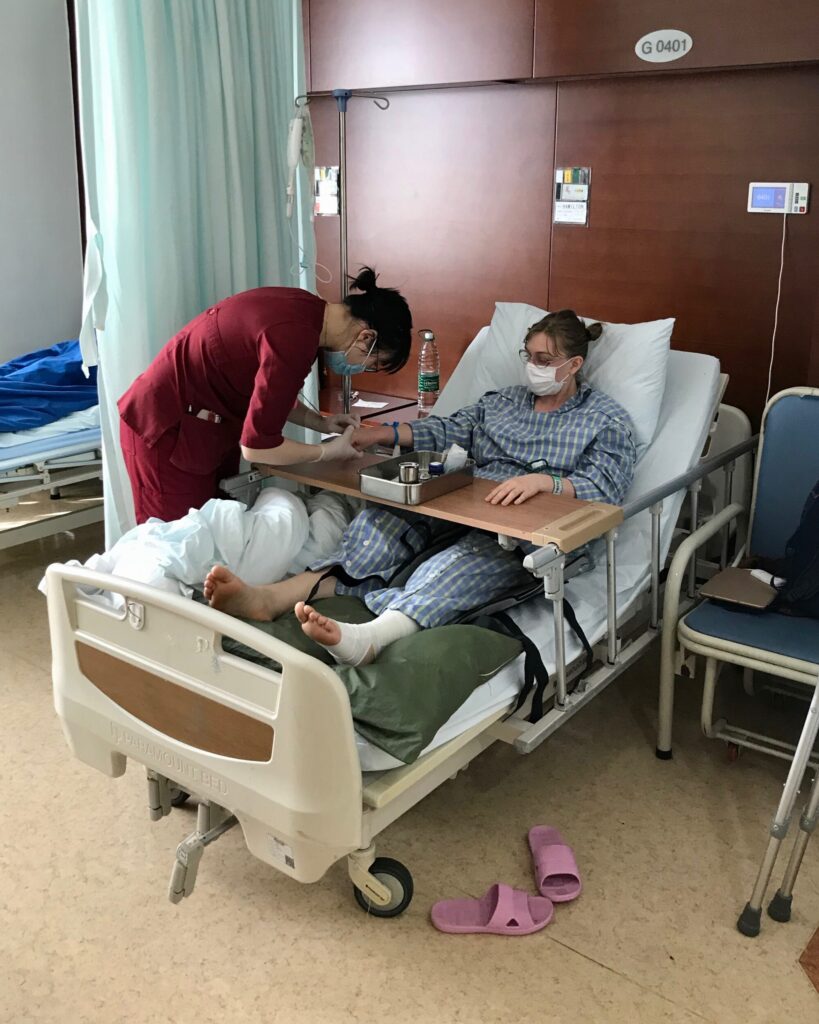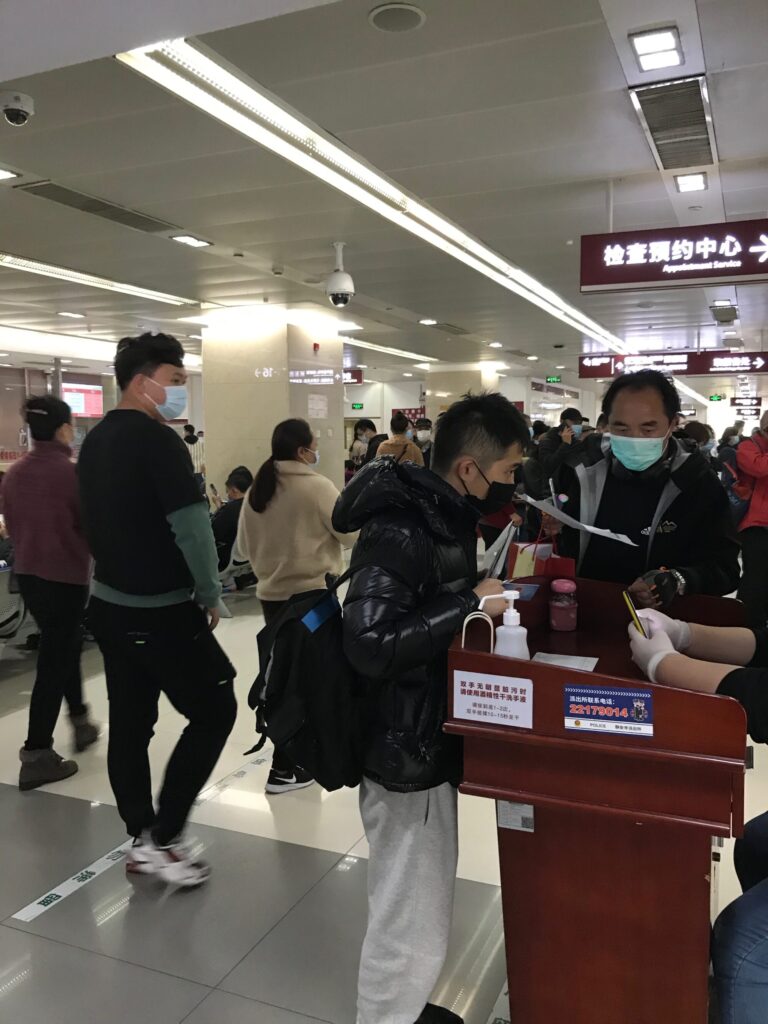Last fall, we visited the emergency room of a Chinese public hospital when my life-partner and bride-to-be injured her knee. It was interesting, and the doctors gave us the impression that it would just heal on its own. Of course, it didn’t.
She ended up having surgery at the end of February this year. Things are slowly getting better, but the bi-weekly follow-up hospital visits are becoming an unending purgatory from which we may never escape.
The Surgery and the Famous Doctor

We went to Huashan Hospital in Pudong for the surgery. It’s actually very nice and quiet for a public hospital in China. They reconstructed the MPFL and the MCL and realigned the patella. I understand Chinese much better than medical terminology, but from what I gathered they had to move the kneecap and tie some tendons back together.
Guess who performed the surgery? None other than Yao Ming’s doctor.
On the day of the surgery, an elderly orderly who didn’t speak any English (but was very friendly) had me help push her bed down to the surgery area. Then the love of my life disappeared behind two mysterious doors. All he said to me was “wait here.”
So, I waited. And waited. I had no idea how long the surgery was supposed to take, and no way to ask anyone about it. My phone battery soon drained to almost nothing. I paced up and down the hallway, counting as many steps as I could. I got up to five hundred.
Finally, four hours later, the doors burst open and two nurses wheeled Rachle out. She was crying in pain. China’s hospitals are not very free with the painkillers.
However, over the next few days, the nurses were all very nice and attentive. And Yao Ming’s doctor was great. He came by later and explained why everything took so long, but said it all looked good. The surgery was a slam dunk. We just needed to do some physical therapy and change the bandage every three days.
Why Can’t Anyone Change the Damn Bandage at a Chinese Public Hospital?

You wouldn’t think that changing a bandage would be that big of a deal. Any nurse should be able to do it. Heck, I think I could probably do it.
We went to the much more crowded Puxi branch of Huashan hospital to get the bandage changed. It’s closer to home, but more typical of a crowded Chinese public hospital. People push and shove to get to the elevators and up to their appointments. Crowds gather in the hallways outside of the waiting rooms. It’s like attending some super popular medical sporting event. Or trying to travel during Chinese New Year.
It’s overwhelming when you’re feeling healthy. It’s terrifying when you’ve just gone through surgery and your knee still hurts and you can’t walk very well.
I paid 300 yuan (or about $46 US) to rent a wheelchair. That helped a little. Of course, there was no room in the elevators for a wheelchair, and nobody was moving out of the way. They probably couldn’t have if they wanted to.
Our Chinese coworker and I left Rachle sitting by a random pillar downstairs, and went up-stairs to try and see a doctor. The people at the desk told us there wasn’t anybody there today who could change the bandage. We’d have to try again tomorrow afternoon.
Why the hell couldn’t a nurse or someone just do it? How hard is it to change a damn bandage? Unfortunately, these are questions I don’t have the language skills to ask. I ended up calling a much more expensive private, international hospital.
Removing Stitches and Getting a Gua Hao

A week later, we returned to get the stitches out. Physical therapy ended at 11:30, so we had to wait till 1:00 for the lunch break to end. When the nurse came back, she told Rachle to stay in the waiting room, and for me to go back and wait in the narrow hallway where the examination rooms were.
The doctor came back from lunch at 1:30. People kept showing up, until the hallway was filled with crutches and busted legs. They all had little slips of paper with numbers on them. I didn’t.
After another half hour or so, the nurse came back and asked me if I had a “挂号”. I had no idea what that was, so I said I didn’t know. She took my hospital registration card and went into the doctor’s office and said something about “foreigners.” Then she came out and told me I didn’t have a “挂号” and I needed to do that.
Thanks to the magic of translation apps, I found out that “挂号” means “registration.” Basically, you need to take a number. Just like the DMV or a deli.
I had no idea how to get this number. I went out in the hallway and started pressing buttons on a machine, and through some sort of lucky magic, I finally got my 挂号. At this point, there were like twenty people who had registered before us. We waited until almost 4:00 to see the doctor.
Had I known we needed this registration number, I could have done so right at 11:30 and been at the head of the line. As it was, we spent seven hours in the hospital that day.
The International Hospital
After our bandage-changing plans were foiled at Huashan, we made an appointment for an international hospital: the illustrious Jiahui Health Center. It was probably the nicest hospital I’ve ever been to.
The first nice thing, was that I could actually make an appointment. We set it for 3:30 and came a little early to register and all that. There was no need for a registration card. No need to get a 挂号.
The staff all spoke better English than I do. They were incredibly kind and helpful. The examination room looked like one of those nice hospital rooms you see on TV shows.
And it was so empty. I saw maybe six other patients in the whole building. Nobody crowding in the elevators. Nobody trying to shove in front of us in line. We could’ve danced in the halls, had Rachle’s knee been healthy.
When we were done, the guy at the door made sure our car came and picked us up right at the entrance. I felt like royalty.
It felt more like a spa or something than a hospital. It was also expensive. The visit cost about 600 RMB, or $100 USD. The same thing was about $12 US at Huashan hospital.
I Never Want to Go to the Public Hospital in China Again

Sometimes you do get what you pay for. And maybe the cost is worth it. Even on the best of days, Chinese public hospitals are frustrating, complicated mazes.
If you visit, you first need to register at the hospital before you can do anything else. It doesn’t matter if your arm is chopped off, you still need that registration card. Then you need to guess where you need to go to get whatever procedure you need done. The buildings are mazes, with long twisting tunnels and convoluted corridors. And of course, you can’t forget to 挂号 or register to get your number. And it’s so damn crowded!
But Chinese people go to the hospital a lot. Every time I get a cold, one of my Chinese coworkers asks me “did you go to the hospital?” It’s such a weird concept to me as an American. Why would you go to the hospital if you’re sick? Even though the Chinese public hospitals don’t cost a lot of money, you pay in time and stress.
It’s probably easier if you’re used to it. And, I will say, the doctors and nurses are all well trained and know what they’re doing. Even still, it’s definitely not one of my favorite parts of living here.
I’m sure the system makes sense in some way that I don’t understand. Afterall, there are literally a billion people who deal with it. But if you’re not used to it, it really sucks.
It’s all part of the culture shock, and it ain’t easy to deal with.

